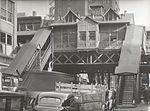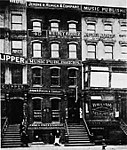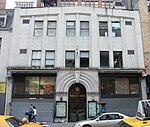NoMad Piazza
Economy of New York CityNew UrbanismUrban design

NoMad Piazza is a pedestrian venue located in New York City on Broadway between 25th and 31st. The area, within Manhattan's NoMad neighborhood, was cordoned off to traffic as part of the NYC Open Streets program, which is run by the NYC DOT, in an effort to allow restaurants to expand outdoor dining as was required for social distancing measures put in place by the city in 2020. Parts of the road closure have since become permanent and local businesses have made their move into the streets a salient feature of the area. The St. James and Townsend Buildings reside in the southern block and 31st street serves as the north boundary.
Excerpt from the Wikipedia article NoMad Piazza (License: CC BY-SA 3.0, Authors, Images).NoMad Piazza
West 26th Street, New York Manhattan
Geographical coordinates (GPS) Address Website Nearby Places Show on map
Geographical coordinates (GPS)
| Latitude | Longitude |
|---|---|
| N 40.745 ° | E -73.990833333333 ° |
Address
Capitol at Chelsea
West 26th Street 55
10010 New York, Manhattan
New York, United States
Open on Google Maps







